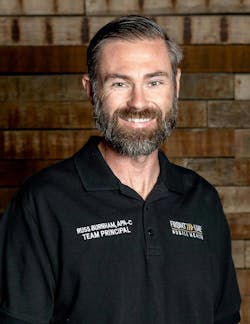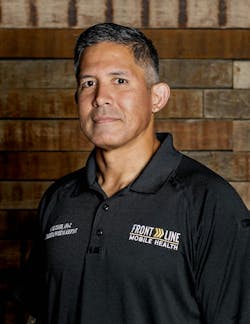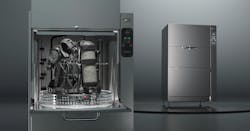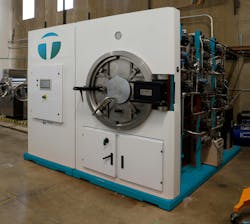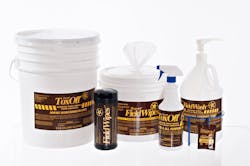Health & Wellness: The Hard Truth About Cancer Prevention
Firefighters face a unique set of health risks: No sh*t. You already know this. Countless articles exist. Often the topic is covered in at least a handful of presentations at any major fire service trade show.
Truth be told, health risks still come down to one of three things: cardiovascular disease, cancer or suicide. Every group has its own opinion about which is the leading cause of firefighter death. All of these groups have good data that tell us each of these areas of need for reducing these risks to firefighters and their health.
The goal for firefighters should be to leave the occupation the way that they want to, not the way that they have to because of illness or injury. Perhaps more important, firefighters should be looking to drain the retirement systems they’ve poured money into and to have an opportunity to spend many more years with loved ones after they leave the service.
Bottom line: You chose a job that has certain health risks. Much like those who signed up to serve in the U.S. Army, the reality of increased danger, whether from operating in the field or exposure-related diseases, is accepted. Cancer, cardiovascular disease and suicide are all major threats.
However, here’s the hardest truth of all: Effective cancer, cardiovascular disease and suicide prevention is free. It doesn’t require massive department budgets, grants or legislative changes. It just requires doing something that’s within your control.
The science behind the risk
A 2023 Mayo Clinic study revealed that abnormalities in exercise stress tests predict not only cardiovascular death (heart attack, heart failure) but also noncardiovascular deaths, primarily cancer, at an almost 2:1 ratio. The study reviewed cardiorespiratory fitness (CRF), or maximal oxygen uptake (VO2max), and compared it to mortality statistics.
The study identified three primary indicators of increased risk:
- Low functional aerobic capacity (VO2max): VO2max is the body’s capability to efficiently use oxygen during intense physical activity. A lower VO2max is associated with higher mortality risk.
- Abnormal heart rate recovery: Heart recovery rate is the speed at which the heart rate returns to normal after exertion. Poor recovery is a predictor of both cardiovascular and
cancer mortality. - Low chronotropic index: The chronotropic index indicates the capability of the heart rate to increase properly during exercise. A sluggish response can indicate hidden cardiovascular disease.
For firefighters, this is critical information. Of course, firefighting is an extreme exertion profession. Every alarm bell could mean a high-stress, physically demanding situation. If your functional fitness is lacking, you not only are at a higher risk of sudden cardiac death but also are more vulnerable to long-term diseases, such as cancer.
What does this mean for firefighters? Cardiovascular health is inseparable from cancer risk. If you neglect your heart, lungs and vascular system, you set the stage for both immediate dangers (heart attack) and long-term threats (cancer and metabolic disease).
Managing metabolic disease
Studies also highlight the strong link between metabolic dysfunction and an increased risk of multiple cancers. Firefighters already face high exposure to carcinogens, but many don’t realize that metabolic syndrome—regardless of body weight—drastically increases cancer risk.
Research shows that individuals who have metabolic dysfunction have a significantly higher chance of developing various cancers:
- Breast: 13 percent–573 percent
- Colorectal: 14 percent–161 percent
- Endometrial: 37 percent–120 percent
- Gastric: 18 percent –150 percent
- Liver: 113 percent–406 percent
- Pancreatic: 58 percent–113 percent
Survival rates are significantly lower for firefighters who have metabolic dysfunction. Breast cancer survivors who have metabolic syndrome at the time of their diagnosis are 83 percent more likely to die from cancer and 69 percent more likely to experience a recurrence.
Firefighters who have metabolic dysfunction at the time of their are at as much as 90 percent higher risk of dying from digestive tract cancers.
These numbers make one thing clear: Metabolic health is a critical factor in cancer prevention.
The ultimate shield CRF—or functional aerobic capacity, as Mayo Clinic phrases it—is a measure of how well the heart, lungs, blood vessels and muscles work together during exercise. A higher CRF means a lower risk of cardiovascular disease and cancer.
A 2018 study in the Journal of the American Medical Association found that CRF is inversely associated with all-cause mortality. This means, in other words, that the higher one’s CRF, the lower the individual’s risk of dying from anything, including cancer.
How does CRF protect against cancer?
- Improves hormone regulation. High fitness levels help to balance insulin and other metabolic hormones, which reduces the likelihood of hormone-driven cancers.
- Reduces inflammation. Chronic inflammation contributes to cancer development. High CRF levels combat systemic inflammation.
- Enhances immune function. Stronger cardiorespiratory fitness means better immune surveillance, which allows the body to identify and fight cancerous cells more effectively.
Role of fitness policies
Fire departments nationwide have made major cancer-prevention advances, such as two sets of gear, gear exchange programs, measuring noxious gas levels before doffing SCBA, multiple hoods, Clean Cab initiatives, decontamination protocols and clean public safety buildings.
These are important steps, but here’s the harsh reality: Many firefighters have access to these tools but don’t use them consistently. Prevention only works if it’s applied.
Departments often argue, “We don’t have the money for these programs.” Yes, financial constraints are real, particularly for volunteer and rural departments, which accounted for 52 percent of firefighter line-of-duty deaths in 2022. However, again, the most effective cancer prevention strategy—improving cardiorespiratory fitness—doesn’t cost a dime.
Implementing CRF
Achieving high CRF doesn’t require expensive gyms or fancy training programs. The best and most cost-effective way to improve CRF is aerobic Zone 2 training, which involves maintaining a heart rate at 60 percent–70 percent of max capacity. If you aren’t armed with a heart rate monitor, a good rule of thumb for Zone 2 training is maintaining a pace at which you can have a conversation, but the person who you’re talking to knows you’re exercising because you’re a little breathless. We call it the “talk test” or “conversational cardio.” Optimally, you maintain this pace for 30–45 minutes per session, and you do these sessions three to five times per week.
It doesn’t matter which activity—walking, jogging, cycling, rowing—as long as you’re in Zone 2. In fact, we often ask our patients, “What cardio do you hate the least? Let’s build a program around something you will actually do.” This truly is simply progress over perfection. This improves mitochondrial function, heart rate recovery and chronotropic index—all of which are linked to better survival outcomes. Most importantly, it’s free.
The last word
Firefighters are great at implementing cancer-reduction policies, but the hard truth is that the most effective strategy is fitness, and it costs nothing.
Improving cardiorespiratory fitness is the best defense against cancer, cardiovascular disease and suicide. The science is clear: Higher CRF equals lower risk of death from all causes. Plus, increasing CRF is a lot easier and less expensive than you might believe.
So, stop complaining about what your department doesn’t provide to you or doesn’t have the money for. It’s time to accept the fact that the most effective cancer-reduction strategy is in your own hands.
Small Changes, Big Results
· Incorporate CRF training into your department’s fitness policy. Make it a requirement, not an option.
· Encourage Zone 2 training. It’s easy, low-impact and highly effective.
· Normalize fitness culture in the fire service. Set the expectation that firefighters must be fit for duty.
Product Spotlight
Cleaning & Decon Products
Hygenall manufactures Firefighter Cleaning and Decon products for the full lifecycle of firefighters, from when they arrive until they go home. The products are designed to remove both chemicals that regular soap cleans off and chemicals that regular soap doesn’t clean off very well. The product science works by using a molecule that electrostatically displaces chemicals on the surface and then cleans them away.
HYGENALL.COM
Decon Washer
Acclaimed for its outstanding quality and washing results, the Solo Rescue decon washer offers automated cleaning and decontamination of PPE. The innovative design ensures efficient results without compromising the function and quality of PPE. NFPA-compliant, the machine is a vital piece of equipment for any department that aims to reduce the amount of toxic chemicals and carcinogens that its firefighters are exposed to daily.
RESCUEINTELLITECH.COM
PPE Decontamination
Tersus Solutions’ CO2-based machine is designed and built specifically for firefighter decontamination. The company’s technology removes 98 percent of contamination. Working with more than 200 departments across the country, Tersus Solutions services are available to firefighters through owned equipment, independent service providers or shipping directly to Tersus.
TERSUS-SOLUTIONS.COM/PPE
About the Author

Russ Burnham
Russ Burnham is a physician assistant and writer. He has an extensive military background, starting with his training at the U.S. Army Medical Department in the Interservice Physician Assistant Program and Tripler Army Medical Center. Burnham finished his Army career as the senior medical advisor for 1st Battalion, 3rd Security Forces Assistance Brigade. During his time in the military, he provided medical care in austere environments. Burnham is only the second soldier in history to be recognized as the U.S. Army Soldier of the Year. Recognizing the parallels between the fire service and Army aviation, he researches the dynamics of how cardiovascular disease, cancer and human performance intersect. He is a member of the American College of Cardiology, the International Association of Fire Chiefs and the NFPA.

Michael Conner
Michael Conner served in the U.S. Army as a platoon leader, company commander and staff officer at the Battalion to Division level. After he earned a master’s degree in physician assistant studies, he served as a primary care manager for a U.S. Army Cavalry Squadron. Conner contributed to the Interservice Physician Assistant Program at the University of Nebraska Medical Center, playing a crucial role in the education, mentorship and supervision of physician assistant students. He later served as the primary care manager for pilots and aviation support personnel, a special staff officer advising on all medical issues, a neurosurgery physician assistant and the chief of clinical operations for the 2nd Infantry Division. Conner worked as an independent medical consultant with Medical Equation, focusing on litigation and workers’ compensation cases. He co-authored publications on firefighter health and fitness and is a member of the American College of Cardiology, the National Strength and Conditioning Association and the NFPA.

